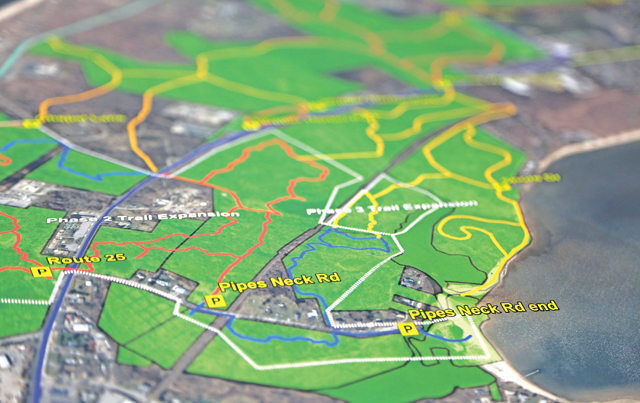Bay to Sound project continues to progress with miles of new trails


As local government agencies near completion of Phase II of the Bay to Sound Integrated Trails Initiative, a town official updated members of the Mattituck-Laurel Civic Association last week on what lies ahead for the project.
As of March 25, the project’s second phase has resulted in 2.1 miles of new trails, 78 additional acres ready to be opened to the public and four new boardwalks to allow safe travel through wetland areas along the trails. Looking further into Phase II expansion, John Sepenoski of the town’s geographic information systems said his team and local village, town and county volunteers plan to make restorations at Skipper Horton Park and find new ways to protect the North Fork’s wildlife, while still giving the public opportunities to enjoy it.
“Work that we still need to complete on Phase II — the construction of two wildlife observation blinds, the construction of five more boardwalks, the construction of two new trail head parking areas … and the creation of approximately 1.2 miles of new trails opening an additional 35 acres of open space to the public,” Mr. Sepenoski said.
The Bay to Sound project formally began in 2007. It proposes that a trail network linking Suffolk County land, Southold Town and Greenport Village preserves and parkland be expanded upon such that residents and visitors may utilize the area between the Peconic Bay waterfront and the shores of Long Island Sound.
The village, town and county partnered on the project, which initially received $107,000 in state funding from the Department of Transportation and Suffolk County. Southold Town, Greenport Village and other local organizations matched those funds to the tune of $52,000. In 2016, the partners applied for grant funding and were awarded $245,000 by the Department of State under Title 11 of the Environmental Protection Fund. Those funds were specific to the project’s second phase, which began in April 2016.
The first phase, on the other hand, lasted from the project’s inception through 2015, a period during which volunteers spent a total of 530 hours identifying and engaging in the cleanup of dumping grounds in dilapidated buildings and the removal of septic systems.
“As of the completion of Phase I, 234 acres of the preserves and parkland were considered open to the public,” Mr. Sepenoski said. “We had 6.5 miles of nature trails and we also had seven miles of bike paths that were part of Greenport Village’s bike trail system and Southold Town’s Seaview Bike Trail System, as well as NYS-designated bike Routes 25 and 114.”
A staggering 29,250 pounds of trash and junk equipment were removed from the project area during Phase II, a figure that took many aback during the meeting. Also in the works for Phase II is the development of educational materials and public outreach related to stormwater, habitat restoration, the Peconic Estuary and the Bay to Sound Project, according to Mr. Sepenoski.
Many locals were curious as to whether potential bike trails might be in the making or whether any existing trails were suitable for cycling.
“Not at this time,” Mr. Sepenoski said. “The bike trails are the ones designated on the streets, but the open space at this point, that’s not going to happen. The county’s permission for all the properties that they hold was strictly for hiking trails.”
Others were concerned about an overwhelming number of designated markers along the trails, specifically citing those near Laurel Lake.
“A lot of those are not actually the town’s markers,” Mr. Sepenoski said. “At one point, there were four competing groups. One of them was stealing our signs and using thumb tacks to put them up in different places. Originally, the town put some of them there … we use the little red/green/blue arrows and it says ‘trails.’ ” The false markers, Mr. Sepenoski said, are hugely distracting because, at points, they result in hikers trespassing on private property, including some of the Suffolk County Water Authority’s holdings.
Plans for Phase III and beyond were announced at the meeting as well. Most notably, Phase III will include native plantings and habitat restoration of farming areas, while future phases might lead to additional trails spanning over 100 acres.
“Probably the number one question I’ve gotten over the past two years on this project is: When will it be done? And my answer is always: I don’t know,” Mr. Sepenoski said. “In part because this was originally conceptual. It’s basically turning 12 years old this year, but we’ve just slowly worked on it and as we’ve worked on it, we’ve acquired more property.”
After the completion of Phases II and III and the future expansion plans, the trail system would include 16 miles of trails, Mr. Sepenoski estimated.








